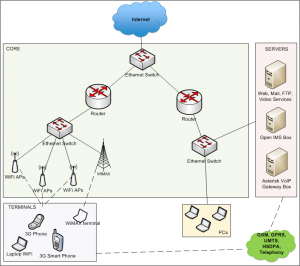OTE platform provides the cognitive platform (based on SW) to the consortium along with access wireless nodes which are constituted from Soekris based WiFis and a WiMAX BS. The aforementioned platform has the ability through monitoring position and network related information to make decision and proceed to execution for the most efficient operation of the network. It performs users horizontal and VHO to the right access network and alleviate problems that arise from traffic overload, interference issues and QoS provision. This cognitive platform uses Soekris based IEEE 802.11 WiFis, WiMAX testbed and multimode terminals.
Platform Description
OTE cognitive platform is compatible with a number of radio access, core and terminal technologies for experimentation. The current environment is divided in five different sections:
- The core network consists of two core routers interconnected through a switch to the Internet. Each core router serves specific functionality for the prototype. The first provides interconnection to the different deployed wireless networks. The second stands as gateway for the servers and the terminals. More precisely, 6 Soekris communication computers and 2 Linksys APs form the WLAN networks. A WiMAX Base Station forms another network technology.
- The terminals have interfaces to a large number of access technologies, namely WLAN, GSM, GPRS/EDGE, HSDPA. Specifically, two HTC (X7500, E3600) devices and one Motorola A910 handheld devices support GSM, GPRS/EDGE and WLAN connectivity. The HTC phones also support connectivity to HSDPA. On the other hand, the HP iPAQs rx7300 and NOKIA 770 support experimentation with WLAN only.
- The Servers are dedicated multiprocessor boxes with extensive memory capabilities, hosting services like Apache web server, mail server, FTP, video streaming, OpenIMS, Asterisk VoIP gateway.
NOTE: OpenIMS will be possibly used for the second phase of the project.
- The MeshNetics sensors are used to sense various parameters of the environment.
- The Desktop PCs are used to simulate regular users as well as to generate traffic and/or consume the provided services.
Below there is an indicative (concerning the number of the devices) graphical representation of the cognitive platform:
Hardware components
The hardware components included to the system are: 4 soekris Net5501-70, 2 soekris Net4801, 1 Redline WiMAX Base Station, 2 Linksys WRT54GL, 2 Linksys WRT54G, 2 HTC (X7500, E3600), 1 Motorola A910, 2 HP iPAQs rx7300, 1 NOKIA 770, 1 WiMAX user terminal, 10 HP 530 laptops, 14 Desktop PCs (4 Intel Core 2 quad CPU @ 2.4GHz, 4 GB memory).
Soekris devices are designed for use as routers, switches, firewalls, access points and other lightweight networking appliances. They are based on Geode single chip processors with an x86 architecture and target on running open source operating systems, like FreeBSD, OpenBSD, NetBSD and Linux. The key characteristic of these devices is the provision of greater programming flexibility than dedicated network devices (i.e. a CISCO router or a NetGear access point). In the current infrastructure, they are equipped with an Atheros MiniPCI 802.11a/b/g card.
Software components & APIs
In terms of software, the platform provides the accompanying programs and monitoring utilities required for the successful deployment of numerous scenarios. Specifically, each network element is managed by the incorporated (self-) management software entity that monitors the network and triggers any required actions (i.e. reconfiguration, self-healing etc). The platform may support the validation of the following scenarios:
- Context management (monitoring, mapping to global information model, storage)
- Service adaptation
- Reconfiguration management and control (protocol reconfiguration and self-healing)
- Policy based autonomous decision making
- Network side software
- OTA software provisioning
- Personalized value added service provisioning
- Distributed decision making for network optimization
- Load balancing
- Client side software
- Self-optimization of resource usage
- Service adaptation
- Autonomous RAT selection
- Self-organisation functionalities for Ad-Hoc cluster formation
Data Base
In addition the platform interoperates with a management system based on java scripts, PERL and MySQL that monitors and manages all the elements of the network.

